Sharing the aroha: World-leading apartment block creates sustainable, community living
Essentials
Name: 26 Aroha
What: A sustainably-driven, low-carbon, community-orientated built-to-rent complex with 13 self-contained apartments. Shared facilities make up 30 percent of the building
Big picture purpose: Sets the scene for more secure tenancies in the New Zealand rental market by offering longer leases, fostering an environment where tenants have a sense of homeownership. A shift towards removing the stigma of renting
The building: A four-storeyed complex on a 900 square metre site. Apartments range in size from studio, one, two and three-bedroom. Communal rooftop with shared laundry, kitchenette, library, toybox, coffee machine, BBQ, and outdoor lounge with city wide views. Bookable guestroom for visitors, storage cages, bike/scooter storage, e-bike charging points, bookable shared electric car. Carparking is kept to a minimum with two rentable parks on site prioritised for residents with children
Where: 26 Aroha Avenue, Sandringham, Auckland
Occupancy: 30 people – from toddler to 50 years plus
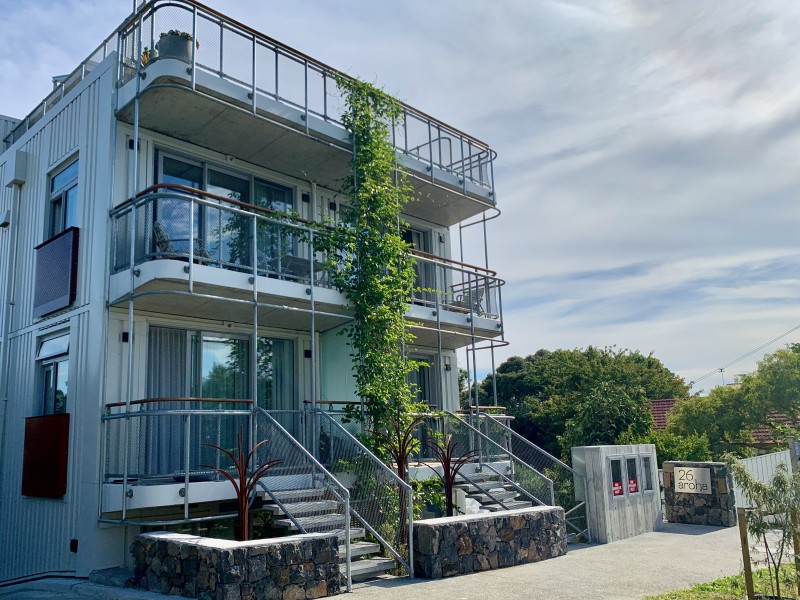
Sitting in a bean bag on a shared rooftop terrace above your world-class green rented apartment sounds like a dream. So too does tending to communal vegetable beds, citrus trees, passionfruit vines, feijoas, apple and plum trees as part of a convivial monthly working bee where residents share the workload, a glass of wine and produce harvested.
Providing a daily dose of uplifting moments in a sustainable, socially orientated building were central themes when Blair and Jules MacKinnon replaced a 1920s bungalow in the inner-city Auckland suburb of Sandringham with a striking 13 apartment built-to-rent development.
Five years after Blair and Jules were at the drawing board, 26 Aroha has been awarded a 10 Homestar rating placing it in the top echelon of green residential buildings and setting a new benchmark for rented apartment living in Aotearoa.
“From the outset we simply focused on designing a building that met the standards of environmental performance we believed people would want to live in. We’re delighted our priorities align so closely with Homestar and for us the 10 stars is an endorsement of our thinking,” Blair says.
Project Snapshot
Owner: Blair and Jules MacKinnon
Architect: Jasmax
Main contractor: Vivian Construction
Homestar assessor: Ella Osborne
Project timeline: (2016) 3 year planning and design phase/eco-demolition of existing 1920s bungalow on site (March 2019) construction phase (August 2020) occupancy
Project certification: 10 Homestar rating (October 2021)
The MacKinnon’s thinking and philosophy on the natural environment and community has been shaped by their individual stories.
“Julie is a former nurse so creating a healthy living environment was always one of our design priorities. Between us we were brought up to be frugal and not waste, with family first, inclusivity, sharing and helping where you can. The project made us think about how to enable others through the way homes are designed.”
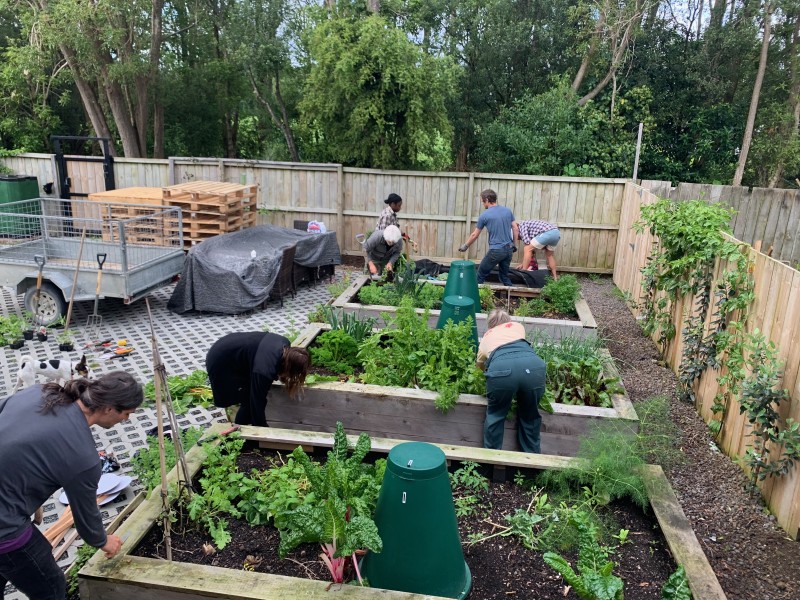
The couple says the Homestar tool has been a great way of measuring how successful they've been at building highly sustainable and healthy homes and to illustrate that to the people living at 26 Aroha.
“Homestar is a real benefit to a developer benchmarking the sustainability of a housing product for the first time. Many homes and products claim to be sustainable. Homestar tells residents to what extent that criteria has been met.”
Blair and Jules say changes to local authority policy propelled the transformation of their Aroha Avenue property from single dwelling to 13 self-contained homes.
“Auckland’s Unitary Plan was encouraging higher density housing around transport, shops and schools. We felt a building designed to help people reduce their environmental footprint in their apartments, with more shared space, facilities and neighbourly contact, would be something current and future generations would want.”
Inspired by so called ‘European apartment living’ the couple undertook a fact-finding mission visiting 10 world-class apartment buildings in Europe and Australia. In addition, they studied the Living Building Challenge principles.
“Many European cities have faced the population growth and housing shortages Auckland is experiencing. Those cities have wrestled with how to transform themselves into a higher density living environments and they have great lessons to share.”
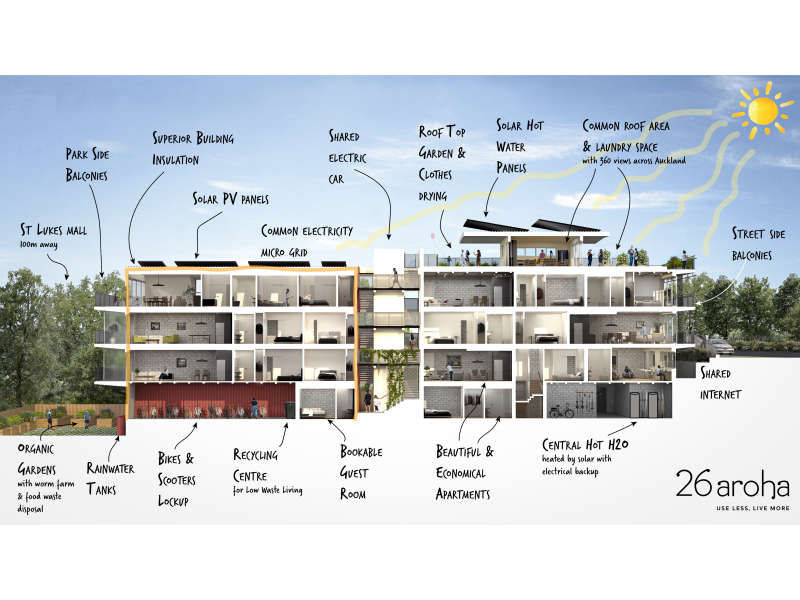
Blair and Jules’ findings were instrumental in shaping 26 Aroha.
Jasmax principal architect and residential design leader, James Whetter says “the owners turned up on day one with a very clear, compelling project vision for low impact living.”
“In the first instance 26 Aroha seeks to provide a high-quality rental experience typically reserved for owner occupiers. Further, the design is a vehicle to build a cohesive community of residents.”
He says during the project the client and design team pushed for a raft of environmental wins.
Sustainable highlights include passive thermal design using orientation, high levels of insulation and thermal mass (almost no heating required in apartments) and waste minimisation methods which have dramatically reduced the level of waste heading to landfill compared with a typical development.
“The building will be there for 50 to 100 years, and the impact 26 Aroha has on the planet is significantly reduced because of its sustainable features. It is good for the industry to have Homestar endorsing such projects so that more may follow,” James says.
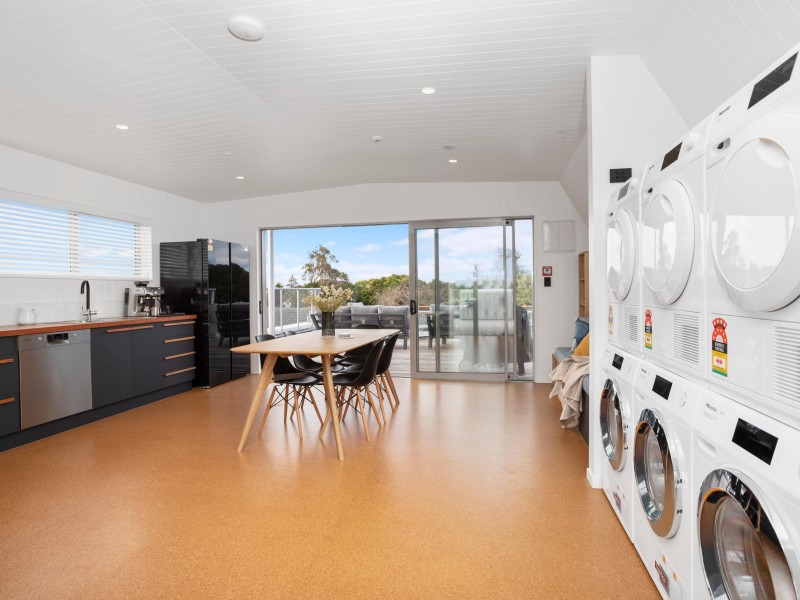
To say 26 Aroha has packaged and delivered the MacKinnon’s aspirations is an understatement.
What the couple most love about the building is that people love living in it.
Unsurprisingly 26 Aroha has a waiting list of potential tenants and those fortunate enough to live at the address are exuberant with their praise.
“Community and facilitating sustainable living in a practical format is the X factor at 26 Aroha. The green sustainable theme tends to attract people who share similar values, people look out for each other and genuinely care about their neighbours,” says studio apartment tenant Marianne Escalante.
“My husband and I love that we’re actually doing it – we’re living the way of the future. Simple design, quality appliances, proper insulation, air circulation, our veggie garden – it all contributes to the way you feel and operate in your own space. It fosters happiness, health and well-being. We really look forward to coming home each day. It’s what we hope will become the ‘new normal’ for everyone.”
That 26 Aroha demonstrates ‘a new normal’ in the New Zealand rental environment is a cheering thought.
Even against a backdrop of ramped up interest in greener homes and lifestyles 26 Aroha is in a league of its own.
The second apartment building in Aotearoa to be awarded a 10 Homestar rating, Project ESD consultant and Homestar assessor Ella Osborne describes it as a “triple threat.”
“It has been designed to achieve best practice environmental outcomes through extensive energy and carbon modelling, social outcomes through the creation of communal shared spaces and healthy indoor environments, and economic outcomes by providing quality rental apartments where people can make a home with building systems designed to significantly reduce operational energy and water usage etc.”
Ella says the project has been a personal highlight to work on.
“From the start Blair and Jules’ vision was not just to build a building but to create a friendly community hub where people could live in a sustainable and affordable way with minimal impact on the planet. The 10 Homestar rating is a true testament to their passion and progressiveness.”
Ella says a dedicated team continuously improved environmental outcomes during design and construction “resulting in the delivery of a world-class sustainable building.”
“For me it’s the small touches and personal connections that I love - a worm farm made from the bathtub from the old house, reused timber, the reading nook in the rooftop hub, the children’s sandpit in the shared garden.”
Ella says built-to-rent apartments like 26 Aroha are a springboard “for achieving social and sustainable outcomes people typically wouldn’t see as renters.”
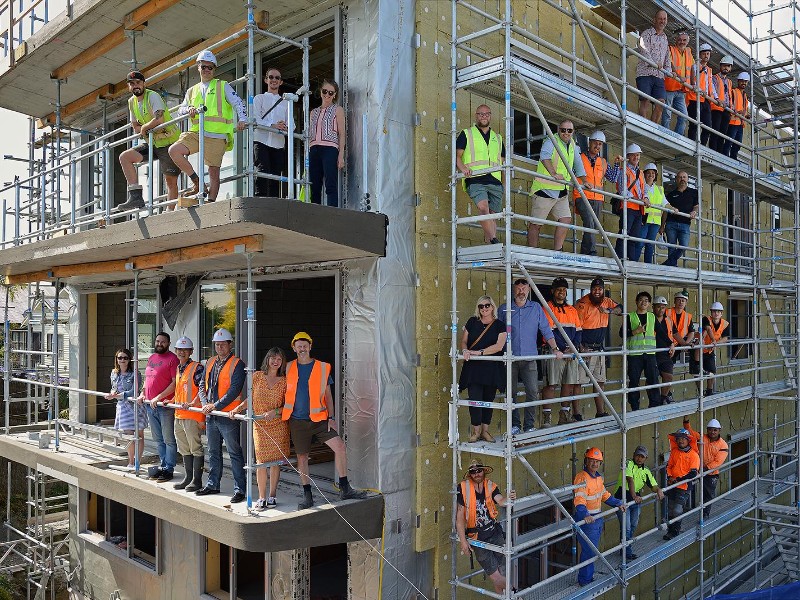
26 Aroha’s main contractor Vivian Construction was well qualified to undertake the build process having completed a number of significant green-themed projects for Ngāi Tūhoe.
“At Vivian we take a sustainable approach with all construction we undertake and completing the first Living Building in this country, Te Kura Whare, (the governance centre and meeting place for Ngāi Tūhoe) at Tāneatua was a significant education piece for our team,” says Vivian Construction director, Jeff Vivian.
“From a construction industry perspective, I believe we have come a long way as our people onsite were already well-versed with the sustainable infrastructure being implemented at 26 Aroha which was incredibly pleasing to see.”
“Ngāi Tūhoe's sustainable values really complement the Homestar process. The 10 Homestar rating has been an incredibly proud moment for us and the consultants – to bring to reality Blair and Jules’ vision that they set out to achieve so many years ago. The project has been a great demonstration of collaboration. To be a part of 26 Aroha is something that will stay with us for a very long time.”
And that unique resonance of 26 Aroha is ongoing.
Resident Sarah Martin says her daily life has been enhanced by living in a warm, dry house all year round, having an efficient appliances and laundry system, shared gardens, very low power and water bills, easy recycling and composting, reduced levels of waste and a lower carbon footprint.
“Living here at 26 Aroha there’s a sense of having a shared commitment to the environment amongst the people in the building,” she says.
“ The 10 Homestar rating is so well-deserved. I feel very proud to live here and I hope more developers are inspired by Blair and Jules to create amazing spaces for people to live in.”
Green features include:
|
Technical features:
|
